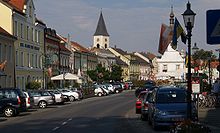Parish Church St. Stephan (Gmünd)
The parish church of St. Stephan is a Roman Catholic church building in Gmünd in Lower Austria . It is consecrated to Saint Stephen .
Location and architecture
The parish church of St. Stephan is located in the northeast of the market settlement on a step over the river Lainsitz . It is a three-aisled complex with a west tower.
The ribbed vault dates from around 1400. The wall paintings, some of which were only exposed at the beginning of the 20th century and in the 1980s, date to the 14th and 15th centuries. The glass paintings from 1903 were created by Tyrolean glass painting .
Facility
The neo-Gothic altars are works by the sculptor Johann Schönbauer from Český Krumlov . On the high altar there are shrine figures depicting the Saints Laurentius , Stephanus and Leopold . Saint Joseph stands in the middle with the baby Jesus in his arms. The left side altar is a Marian altar, the right a Florianialtar. On the pulpit there are evangelist reliefs and on the baptismal font a neo-Gothic essay with a statue of John the Baptist .
The organ has 14 registers , 3 paddocks and 1,040 pipes and was built by the Krenn brothers (1968). The tower contains 5 bells .
history
At its core, the parish church of St. Stephan is a Romanesque building with only one nave , which was built between the end of the 12th and the beginning of the 13th century. Located on the city wall, the church also served to fortify the city. It was probably extended laterally in the second half of the 13th century. Your choir originally dates to the beginning of the 14th century. The church was mentioned in documents in 1278/1280 as the seat of a vicariate and in 1382 as the seat of an independent parish. In the 15th century the side aisles and the arch of the central nave were expanded. Until 1794 the parish church was surrounded by a cemetery.
The east tower, which was destroyed in a fire in 1852, was not rebuilt; the parish church of St. Stephen was replaced by its west tower between 1852 and 1854. In 1903 the church got its neo-Gothic interior. Restorations took place in 1953 and 1978. The choir was expanded in 1981/1982 according to plans by the architect Clemens Holzmeister . In 2008 the square in front of the church was named after Clemens Holzmeister.
Franz Ölzelt , a member of the National Council, was pastor in Gmünd from 1924 to 1938. The pastor of the parish of Gmünd is currently Rudolf Wagner.
Former pastors
- 1640–1643: Johann Pregelius
- 1644–1645: Moritz Stark
- 1645-1653: Martin Holl
- 1653–1667: Michael Franz Wagner
- 1667–1673: Franz Dirnberger
- 1673–1683: Alexander Hagenleithner
- 1684–1688: Michael Wällisch
- 1689–1717: Heinrich Simon de Pluvia
- 1717–1742: Johann Frisch
- 1743–1765: Anton Marbacher
- 1765–1779: Anton Müllner
- 1779–1787: Leopold Weinpolter
- 1787–1789: Johann Walzer ( provisional )
- 1789–1803: Mathias Anton Lippa
- 1804–1811: Franz Hoffmann
- 1811–1823: Johann Baptist Schweiger
- 1824–1826: Jakob Schwibel
- 1826–1832: Alois Joseph Schrenck von Notzing
- 1832–1843: Jakob Mayer
- 1843–1854: Ignaz Zehentner
- 1854–1866: Johann Baptist Mayer
- 1866–1875: Franz Pöschl
- around 1880: Ignaz Blentzer
- 1885–1919: Ferdinand Höbarth
- 1919–1924: Emil Beichel
- 1924–1940: Franz Oelzelt
- 1940–1969: Johannes Weinberger
- 1969–1986: Otto Buchberger
- 1987 – today: Rudolf Wagner
literature
- Bundesdenkmalamt (Ed.): Dehio Niederösterreich north of the Danube , Vienna 1990, ISBN 3-7031-0652-2 , pp. 274–275
- Roman Catholic Parish Office Gmünd-St. Stephan (Hrsg.): Festschrift for the completion of the expansion and interior renovation of the parish church Gmünd-St. Stephan . Gmuend 1982
Web links
Individual evidence
- ↑ Palznich, Franz: The city of Gmünd in Lower Austria - A representation of the same in topographical, statistical and historical relation, Gmünd 1874, p. 56. ( [1] )
Coordinates: 48 ° 46 ′ 24.4 " N , 14 ° 59 ′ 16.4" E

